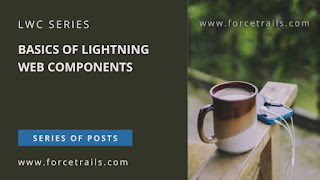Welcome to the LWC Basics Series! This collection of blog posts will guide you through the fundamentals of building dynamic and powerful user interfaces for Salesforce applications with Lightning Web Components (LWC).
Start Your Journey:
- JavaScript Basics
- JavaScript Basics For Lightning Web Components | Part 1
- LWC Tricks for using ES6
- Promises in Lwc | Lwc tricks #2
- Important points for Salesforce Certified JavaScript Developer 1
- Lightning Web Components FAQ
- Basics & Reactivity
- Lifecycle Hooks
- Mastering LWC Connected Callback
- Lightning Web Component Constructor
- Disconnected Callback Life Cycle Hook in LWC
- Data manipulation
- Using Lightning data service with lwc
- Lightning Web Component createRecord example
- Lightning Web Component wired getRecord example
- Lightning Web Component wired updateRecord example
- Client Side Caching and Data Persistence in LWC using Local Storage
- Layout & Styles
- How to create responsive lightning web component
- Using LWC Conditional directives lwc:if lwc:elseif and lwc:else
- Hide-show Element in Lightning web component
- Create Uniform Tiles with Dynamic Content in LWC
- SLDS Styling hooks in Lightning web components
- Customize standard LWC components' with SLDS Styling Hooks
- Detect Device Form Factors in lwc & change the component behavior
- Refresh UI
- getRecordNotifyChange lwc - refresh UI explicitly
- refreshApex & deleteRecord example in LWC
- Use RefreshEvent in LWC to automatically refresh record pages
- Lightning UI APIs
- Lightning Flow
- Apex
- Communication
- Error Handling
- DOM Events & Manipulation
- Key de-bouncing on input in Lightning web component
- Access DOM Elements with LWC Refs
- Dynamic component creation in LWC
- Expose LWC events to Lightning App Builder - Dynamic Interactions
- Get child elements by tag name and class name in lightning web component
- Prompts & Dialogs
- Create prompt dialogs using LightningPrompt in LWC
- Lightning modals with quick action panel component
- Create Lightning Web Component Quick Action Panel
- Validation & Security
- Debugging
Practice Scenarios
Follow the Series:
Stay tuned for more exciting topics in the LWC Basics Series as we delve deeper into advanced concepts and explore best practices for building robust and scalable LWC applications.
Join the Community:
Don't hesitate to share your thoughts, ask questions, and engage in discussions with the community! Let's build the future of Salesforce development together.

No comments :
Post a Comment
Hi there, comments on this site are moderated, you might need to wait until your comment is published. Spam and promotions will be deleted. Sorry for the inconvenience but we have moderated the comments for the safety of this website users. If you have any concern, or if you are not able to comment for some reason, email us at rahul@forcetrails.com